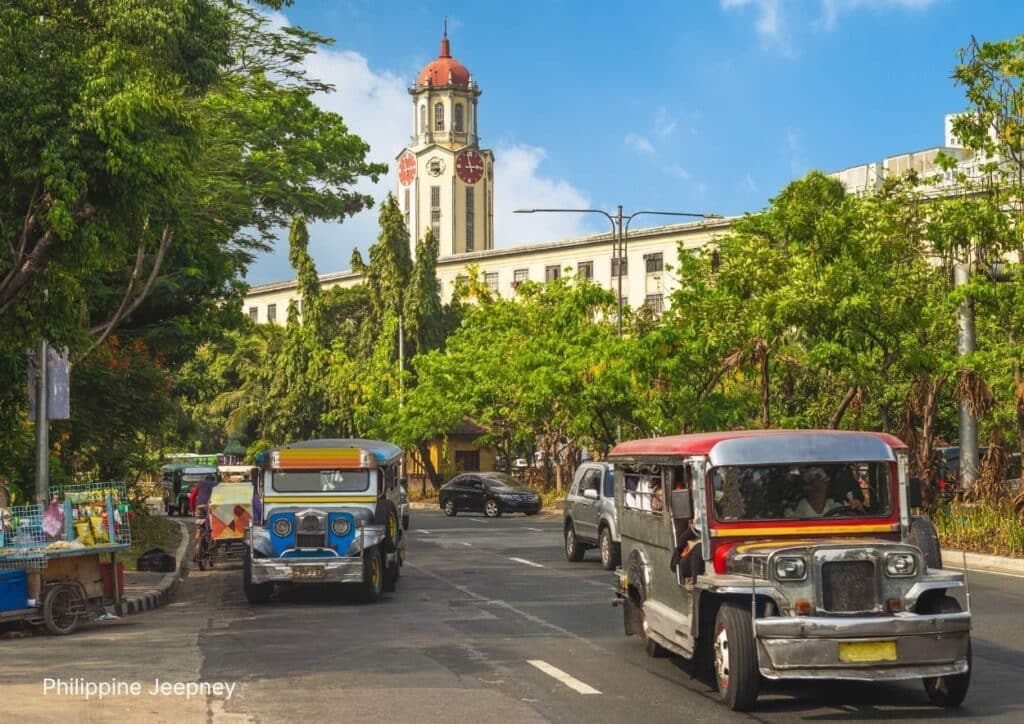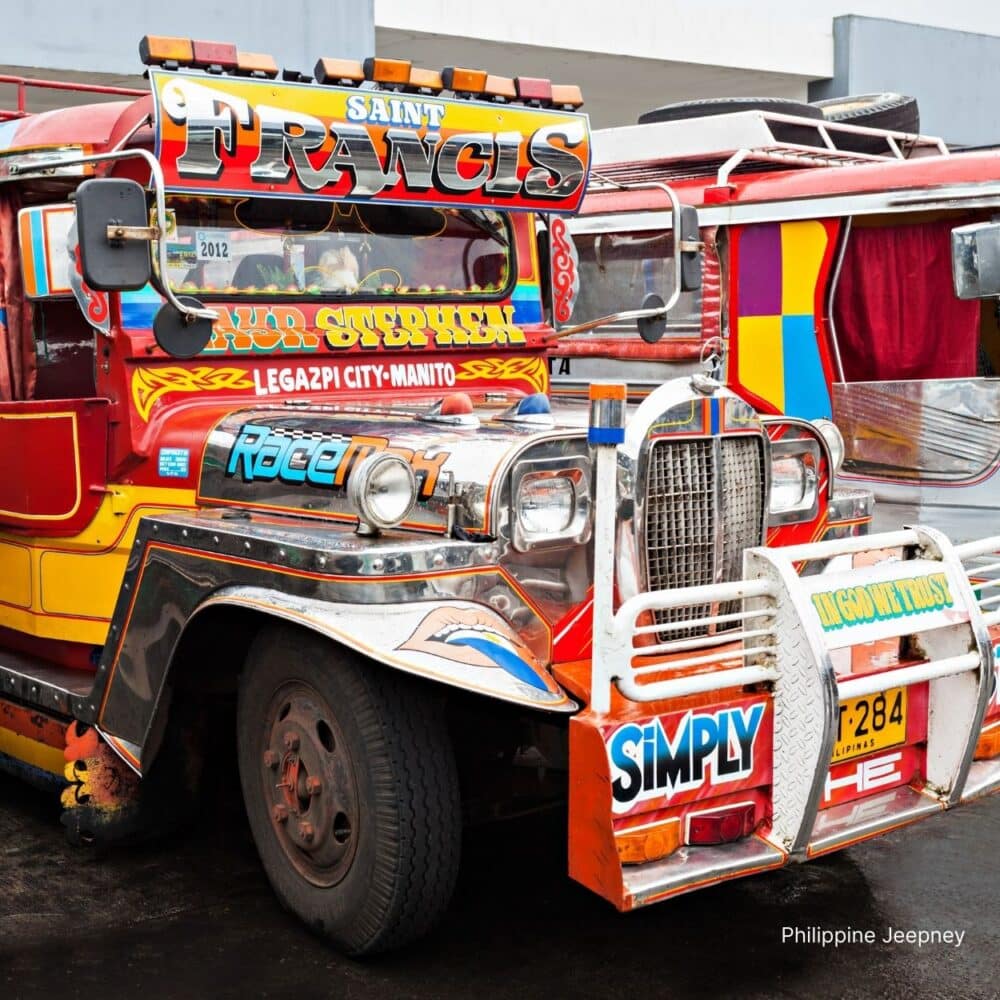If you ever visit the Philippines, there’s one thing you absolutely can’t miss: the Philippine jeepney.
The jeepney in the Philippines is a bright, colorful, noisy, and full-of-life vehicle. These remodeled vehicles have become more than a means of transportation; they have become a moving symbol of Filipino culture.
We need to remember that behind every chrome hood ornament and hand-painted mural is a story that few outside the Philippines know: a tale of war, resilience, creativity, and community.
There’s no doubt that the jeepney is a story that still rolls through the country’s busy streets today.
Continue reading our article to learn more about the significance of the jeepney in everyday Filipino life.
From the Battlefield to the Urban Streets
At the end of World War II, the Philippines was left devastated. Roads were in ruins. Public transportation was almost nonexistent. Meanwhile, the departing American military left behind thousands of Willys jeeps. The Willys jeeps were small, sturdy vehicles that had served U.S. soldiers during World War II.
Rather than letting them rust away, Filipinos got to work on the old Willys jeeps. They stripped down the jeeps, extended the frames, added rows of seats in the back, and covered them with makeshift roofs to protect passengers from the heat and rain.
Voila! The very first Philippine jeepneys were born. While these vehicles were initially made out of necessity, they have become a staple on Philippine city streets. Looking back, the creation of the Philippine jeepney was a clever solution for a country rebuilding itself from the ground up.

Did You Know?
The name “jeepney” is believed to be a combination of “jeep” and “jitney,” a term originating from the U.S. for small, shared taxis.
Art on Wheels
It didn’t take long before simple, practical jeepneys transformed into something uniquely Filipino. Owners began decorating their vehicles with bright and intricate artwork, including religious icons, landscapes, American superheroes, pop culture references, and even portraits of loved ones. At times, owners would enlist the help of well-known artists to decorate their jeepneys.
Over time, the Filipino jeepney evolved into a personal statement, a source of pride, and a moving piece of art for Filipinos. In many ways, the jeepney reflected everyday Filipino values: faith, family, creativity, and a sense of humor.
This was because no two jeepneys were the same in the country. And each jeepney’s uniqueness was celebrated by Filipino families everywhere.
Now that we’ve read about the jeepney’s history, let’s take a look at how the jeepney powered city life in the country in the next section.
The Backbone of City Life
Throughout the 1950s and 60s, jeepneys grew from a quick solution into a nationwide necessity. Many family-run workshops started building jeepneys locally, customizing every part from scratch. The rise of the Philippine jeepneys became a source of income for many in the nation, as it provided more employment opportunities.
As cities like Manila expanded, the jeepney became an essential mode of transportation. Philippine jeepneys provided a cheap and reliable means of transportation for millions of Filipinos to commute to work, school, and home.

Even today, if you ride a jeepney, you’ll experience a shared adventure: handing your fare forward to the driver, squeezing shoulder-to-shoulder with strangers, and hopping off (sometimes while it’s still rolling!) at your destination.
Back then, taking the jeepneys was about more than just transportation; it was also about cultural bonds.
The Unsung Duo: Driver and Conductor
While the jeepney driver gets the vehicle moving, it’s the conductor who keeps the whole operation running smoothly. Known locally as the konduktor or dispatcher, this person is often stationed at the entrance or hanging from the back. The conductor expertly navigates traffic and handles fare collection, all while assisting passengers to board and disembark the jeepney safely.
The driver and conductor operate in near-perfect sync. The conductor shouts out the route (“LRT! Quiapo! Cubao!”), signals stop with a loud tap on the metal roof, and collects fares, often while the jeepney is still in motion. They also ensure passengers get their exact change, even during the busiest rush hours.
As surprising as that may sound, this partnership is founded on trust and open communication. They form a tag team that not only gets people from point A to point B, but does so with efficiency and often a good dose of humor (Many conductors crack jokes with the passengers!).
This dynamic duo is another layer of the jeepney’s cultural heartbeat. It’s a display of teamwork you’ll also find in many Filipino work environments.
However, the jeepney industry has faced some challenges in recent years.
Challenges in a Changing World
Change is always tricky at first.
While the jeepney remains beloved, the realities of modern city life are catching up with it. The fact is that old diesel engines contribute to air pollution. Traffic congestion in places like Metro Manila and Cebu City has become a significant problem.
In response, the government launched the Public Utility Vehicle Modernization Program, aiming to phase out older jeepneys in favor of safer, greener, and more efficient models. Modern jeepneys now feature electric engines, GPS tracking, automatic fare collection, and enhanced safety features.
As expected, change hasn’t been easy. For many drivers and operators — often from low-income communities — upgrading to better vehicles is expensive and risky. Additionally, for many passengers, riding a modernized jeepney just doesn’t feel the same.
The conversation about modernization is still ongoing. The big question Filipinos ask is: how does the country improve transportation while respecting the culture and livelihoods the jeepney represents?
Having said that, Filipinos can embrace the modernization process of neighboring Asian countries.
Why the Jeepney Matters to Filipino Culture And You
The story of the jeepney is more than just a tale of transportation; it is a testament to the resilience of the Filipino people. It’s about how Filipinos turn challenges into creativity, necessity into innovation, and everyday life into something worth celebrating.
These same qualities show up when you work with your Filipino offshore experts:
- Resourceful: They make the most of what’s available.
- Resilient: They persevere through difficulty with optimism.
- Creative: They bring heart and originality into their work.
At CoDev, we believe understanding the spirit of Filipino culture helps build stronger, more human remote teams.
So the next time you see a jeepney, in a photo or on a busy street, remember: it’s more than just a ride. It’s a symbol of the values that drive incredible partnerships, every single day.

More Than a Ride: What the Jeepney Says About Filipino Talent
The Philippine jeepney is a symbol of Filipino ingenuity, resilience, and community. And those same traits show up in the way Filipino professionals work every day.
At CoDev, we connect you with Filipino developers, designers, SDRs, and marketers who share the same spirit.
Ready to work with an offshore team that goes the extra mile? Let’s talk. Book a free meeting today!
